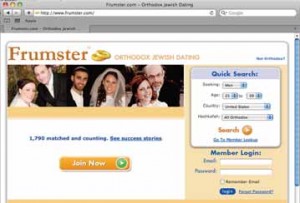Shidduchim Go High-Tech
Technological developments are often aimed at solving the world’s great problems: feeding the hungry, reversing global warming, curing disease. But what about the world’s most pressing problem, at least from a Jewish mother’s point of view: the “shidduch crisis”?
Dr. Tova Weinberg, an exuberant retired dentist who is the shadchan-in-chief of SawYouAtSinai.com (SYAS), has been matching up people since she got married—thirty-two years to date. The first twenty-three years, she says, were spent making shidduchim the traditional way—offline. “It was much harder the old-fashioned way,” says Weinberg. “I had to be given all the references, call them all up. It used to take two weeks to set up one match! Now, I just push a button and I see the whole profile,” she says. Recently described by Time magazine as a “legend in the matchmaking world,” Weinberg, who sets up about 300 dates per week, sifts through the SYAS database from her home in Pittsburgh, Pennslyvania.

Recently described by Time magazine as a “legend in the matchmaking world,” Tova Weinberg has made more than 200 matches.
“If I’m familiar with one of the parties already, I can call and propose [the match] to the other [party] right away,” says Weinberg. “I’m making one call instead of 500 before I get that first ‘yes.’” Weinberg has made more than 200 marriages in the three decades she’s been in the matchmaking business.
E-mail can also speed up the matching process. “Everyone today has a shidduch resume, and everything can be e-mailed,” says Margie Pensak, a shadchan in Baltimore, Maryland. Cell phones also speed up response times. “Singles are sending texts to the shadchan, and in some circles, texting each other after becoming acquainted,” she says. No more frustrating repeated attempts to get in touch with a shadchan or a date—today people are reachable anytime, anywhere.
Online communication also allows singles to cast a wider net, fishing from a cyberpool of potential mates throughout the country and even in other countries. “I can now get information on a shidduch from a foreign country in minutes,” Pensak says.
Traveling to meet a prospective shidduch who lives far away used to involve a substantial investment of time and money, a risky investment by anyone’s standards. “You could pay for a chasunah with what you spent traveling, trying to meet the right guy!” says Jeff Cohn of the MakeAShidduch Foundation. Three years ago he launched ShidduchVision, a program that allows couples to meet via teleconferencing (screens are set up in private homes so couples can “date” without exhausting their bank accounts or vacation days). ShidduchVision works the same way as Skype, but the image is larger and crisper. Couples pay a nominal fee, and are permitted to “meet” up to three times before they’re expected to meet in person.
While ShidduchVision has been used by singles in Toronto, Chicago, Baltimore and Los Angeles, Cohn seems frustrated that more daters aren’t taking advantage of it. “Hashem made technology so we could benefit from it!” he says. “We have the wheel here, but people aren’t riding.”
Online Dating Sites
Many shidduchim are still arranged locally through shadchanim or friends. But if these channels don’t help, Weinberg advises that the next best way to meet a potential mate is through social gatherings: Shabbat invitations, Shabbatonim or weekend seminars geared for singles. If such gatherings don’t work, however, the next level is Orthodox dating sites.
When the first frum dating sites hit the Internet, thirty-eight-year-old Yitz, a single from Brooklyn, says, “There still was a stigma that somehow [they] reflected personal ads.” Now, over ten years later, the stigma is pretty much gone, he says.
No more frustrating repeated attempts to get in touch with a shadchan or a date—today people are reachable anytime, anywhere.
With more than 33,000 participants and 300 shadchanim, SYAS, founded in 2003, already boasts over 1,000 engaged couples. SYAS profiles are available only to the site’s matchmakers until a shidduch is set up. According to Chana, a single at Stern College for Women in New York, the SYAS profiles she sees usually contain more information than those she gets when she’s set up the more traditional way. However, since the shadchanim don’t know the parties personally, the matches suggested, she says, sometimes have a random “skirt-meets-pants feel.”
“I have received a few on-target matches through SYAS,” Chana admits, “and have communicated with a matchmaker who put in effort to get to know my preferences . . . Experiences vary; some people have mentioned getting over a hundred [suggested] matches over the course of a couple of years [on SYAS] and going out with less than ten of those. It all depends on the individual and on the matchmaker he or she chooses.” She acknowledges that the large SYAS database has the advantage of allowing her to meet people beyond her immediate social circles.
The popular site Frumster.com does not use shadchanim, which suits Yitz just fine. Once you’ve joined the site, you’re free to browse the profiles and send messages to anyone. Yitz likes the way the progressive getting-to-know-you process on Frumster allows him to sort through prospects on his own. “There is a communication process,” he says. “Frumster messages, then moving to private e-mail, and then to the phone before actually going on a date—there is enough of an opportunity to rule out someone who might not be appropriate for you.”
But there’s always a danger that online profiles can be misleading. “I heard a story about a woman who met a man through a Jewish dating site,” Pensak, the Baltimore shadchan, relates. “She later discovered, after the relationship got serious, that the man wasn’t even Jewish! For whatever reason, he wanted to meet a Jewish woman, so he went onto those sites.” Many Orthodox sites have instituted screening procedures to try and make sure participants are really who they say they are.
Ben Rabizadeh, Frumster’s CEO, points out that his web site checks into the applicants. “We look for clues to make sure people are Jewish, and check into their communities. We also charge a fee, which helps cut out people who aren’t serious. Our participants are also quick to play ‘Jewish geography,’ calling around to check out potential dates.”
Frumster boasts 19,000 members and has resulted in some 1,786 matches since it was founded in 2001. But isn’t all that choice overwhelming? “That’s true of technology in general,” says Rabizadeh. “There are too many options and some people end up paralyzed.” A myriad of options may also create the illusion that with just enough online “shopping,” one should be able to find the perfect mate the same way one clicks around looking for a perfect pair of shoes.
Online dating checklists are obviously designed to save time and heartache by eliminating unsuitable prospects from the get-go. But while it makes sense to steer clear of wildly inappropriate matches, it is also possible that looking for perfect compatibility may be counterproductive.
“In a successful marriage, it is important that there be differences between the two partners . . . if two people are exactly the same, what benefit is there in marriage?” writes Rabbi Yisroel Reisman, of Agudath Israel of Madison in Brooklyn. He proposes that the best ezer kenegdo, like the best chavrusa, is one who is willing to disagree, because only through working out differences and complementing each other’s strengths and weakness can one grow as a married person (Pathways of the Prophets [Bklyn, NY, 2009]).
Often Words Aren’t Enough
Like the curtain screening The Wizard of Oz, the anonymity of the Internet allows people to hide behind their computer screens. This may be an advantage for the socially reticent, who may find it hard to make a good impression in crowded, noisy singles gatherings, or on a first date. Online meetings allow more subtle strengths to shine through at a slower pace, and the anonymity emboldens a greater freedom of expression. But such conversations may also turn out to be misleading in fact. The single who seemed so dashing online may become awkward and tongue-tied in person, reducing virtual chemistry into face-to-face fizzle. Conversely, people who are less eloquent on a keyboard may actually sparkle in person.
Obviously, in-person meetings are essential to establish whether there’s enough attraction for a relationship to develop. “The dating sites help with networking, speed and matching people up based on the criteria they specify,” says Dr. Efrat Sobolofsky, director of YUConnects, a site that partners with SYAS exclusively for Yeshiva University students. “Face-to-face is always better.”
“Facebook is the future of online dating.”
It is also better because disembodied words leave out crucial nonverbal input. Electronic communication is limited to words, modish abbreviations (LOL, gr8) and the occasional emoticon, so that all-important contextual cues such as body language and tone of voice are absent. “I had an interesting evening” comes across very differently when accompanied by a wide smile and enthusiastic tone of voice compared to a raised eyebrow and ironic tone.
“I find there’s a lot of room for misunderstanding when a guy sends me an IM or a text,” says Rivky, a single from Manhattan’s Upper West Side. “Sometimes it’s hard to tell if a person is being sincere or sarcastic, or just making a joke.”
“The other problem with online chatting,” says Yaacov, a twenty-five-year-old single from Queens, New York, “is that couples find it easier to discuss important issues online—which doesn’t help them learn how to communicate in person.”
Facing Facebook: The Future of Online Dating?
Despite the complaints that meeting online permits too much anonymity, the opposite also sometimes holds true—at least for those with Facebook pages.
“When you allow a date to see your Facebook page,” says Rabizadeh, Frumster’s CEO, “it strips away the mystery of slowly getting to know each other. All of a sudden you see all the person’s photos, all her friends and favorites. You can start feeling like a number, like just one friend amid her hundred or five hundred Facebook ‘friends.’”
Like stand-alone text, photos give only a partial representation of a person. A single frozen image cannot convey a person’s winsome way of speaking, savvy dressing style, or other real-life attractions. But even the “likes” and “friends” listed on Facebook may lead to misunderstanding. “There’s just too much information available,” says Dr. Sobolofsky. “Young people go to a Facebook page and start making generalizations based on the likes and friends that are listed, and then sometimes eliminate people too fast.”
But others find the networking and availability of information offered by Facebook to be an asset. “Over the past year or so Facebook has started to become a great place to meet other singles,” says Yitz. “It’s a much more relaxed atmosphere, and it’s all about networking. I have had numerous Facebook friends suggest matches for me . . . On Facebook, you can ‘friend’ someone and get a real flavor for who she is . . . You can see pictures of her vacations along with what her hobbies and passions are. It’s much easier to approach potential dates, especially when you have mutual friends in common.”
“Facebook is the future of online dating,” Yitz contends.
The Next Stage
Even after a couple meets, technology can help or hinder the course of true love. The guy who’s running late for a date can use a cell phone to warn the young woman there’s a traffic jam on the FDR; but their date may flop if, instead of turning off their cell phones, both are constantly interrupted by messages and calls.
“Today, focus is a big challenge in all our relationships,” Rabizadeh says. “It takes self-control and discipline.”
And when snags arise on the path to the chuppah, Dr. Sobolofsky advises that texting should not be a substitute for talking things out. “People are relying more and more on texting,” she says, “but it can downplay former ways of communication.”
New technologies have great potential to help Jewish mothers solve the shidduch crisis. But, as always, there’s a caveat: electronic communication can serve as the prelude—but never the substitute—for authentic live human relationships.
Barbara Bensoussan has worked as a university instructor and a social worker, and currently writes for Jewish newspapers and magazines. Her most recent novel is A New Song (Southfield, Michigan, 2007).



